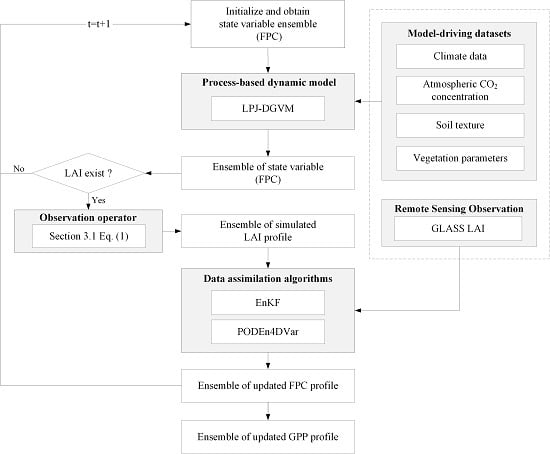Assimilation of Remotely-Sensed Leaf Area Index into a Dynamic Vegetation Model for Gross Primary Productivity Estimation
Abstract
:1. Introduction
2. Study Area and Datasets
2.1. Study Area
2.2. Flux Tower Measurement
2.3. Model-Driving Datasets
2.4. Remote Sensing Observation
3. Data Assimilation Strategy
3.1. Lund-Potsdam-Jena Dynamic Global Vegetation Model
3.2. Assimilation Method
3.2.1. Ensemble Kalman Filter
3.2.2. POD-Based Ensemble 4D Variational Assimilation Method
3.3. Model Performance
4. Results
4.1. Accuracy Assessment of Simulated GPP
4.2. China’s Terrestrial GPP
5. Discussion
6. Conclusions
Acknowledgments
Author Contributions
Conflicts of Interest
References
- Ichii, K.; Kondo, M.; Okabe, Y.; Ueyama, M.; Kobayashi, H.; Lee, S.; Saigusa, N.; Zhu, Z.C.; Myneni, R.B. Recent Changes in Terrestrial Gross Primary Productivity in Asia from 1982 to 2011. Remote Sens. 2013, 5, 6043–6062. [Google Scholar] [CrossRef]
- Yuan, W.P.; Liu, S.G.; Yu, G.R.; Bonnefond, J.; Chen, J.Q.; Davis, K.; Desai, A.R.; Goldstein, A.H.; Gianelle, D.; Rossi, F.; et al. Global estimates of evapotranspiration and gross primary production based on MODIS and global meteorology data. Remote Sens. Environ. 2010, 114, 1416–1431. [Google Scholar] [CrossRef]
- Gebremichael, M.; Barros, A.P. Evaluation of MODIS Gross Primary Productivity (GPP) in tropical monsoon regions. Remote Sens. Environ. 2006, 100, 150–166. [Google Scholar] [CrossRef]
- Kotchenova, S.Y.; Song, X.D.; Shabanov, N.V.; Potter, C.S.; Knyazikhin, Y.; Myneni, R.B. Lidar remote sensing for modeling gross primary production of deciduous forests. Remote Sens. Environ. 2004, 92, 158–172. [Google Scholar] [CrossRef]
- Sitch, S.; Smith, B.; Prentice, I.C.; Arneth, A.; Bondeau, A.; Cramer, W.; Kaplan, J.O.; Levis, S.; Lucht, W.; Sykes, M.T.; et al. Evaluation of ecosystem dynamics, plant geography and terrestrial carbon cycling in the LPJ dynamic global vegetation model. Glob. Chang. Biol. 2003, 9, 161–185. [Google Scholar] [CrossRef]
- Cramer, W.; Kicklighter, D.W.; Bondeau, A.; Moore, B.; Churkina, C.; Nemry, B.; Ruimy, A.; Schloss, A.L. Comparing global models of terrestrial net primary productivity (NPP): Overview and key results. Glob. Chang. Biol. 1999, 5, 1–15. [Google Scholar] [CrossRef]
- Huang, C.L.; Li, X.; Lu, L.; Gu, J. Experiments of one-dimensional soil moisture assimilation system based on ensemble Kalman filter. Remote Sens. Environ. 2008, 112, 888–900. [Google Scholar] [CrossRef]
- Dente, L.; Satalino, G.; Mattia, F.; Rinaldi, M. Assimilation of leaf area index derived from ASAR and MERIS data into CERES-Wheat model to map wheat yield. Remote Sens. Environ. 2008, 112, 1395–1407. [Google Scholar] [CrossRef]
- Ines, A.V.M.; Das, N.N.; Hansen, J.W.; Njoku, E.G. Assimilation of remotely sensed soil moisture and vegetation with a crop simulation model for maize yield prediction. Remote Sens. Environ. 2013, 138, 149–164. [Google Scholar] [CrossRef]
- Evensen, G. The Ensemble Kalman Filter: Theoretical formulation and practical implementation. Ocean Dyn. 2003, 53, 343–367. [Google Scholar] [CrossRef]
- Das, N.N.; Mohanty, B.P. Root Zone Soil Moisture Assessment Using Remote Sensing and Vadose Zone Modeling. Vadose Zone J. 2006, 5, 296–307. [Google Scholar] [CrossRef]
- Li, X.; Koike, T.; Pathmathevan, M. A very fast simulated re-annealing (VFSA) approach for land data assimilation. Comput. Geosci. 2004, 30, 239–248. [Google Scholar] [CrossRef]
- Pathmathevan, M.; Koike, T.; Li, X. A New Satellite-Based Data Assimilation Algorithm to Determine Spatial and Temporal Variations of Soil Moisture and Temperature Profiles. J. Meteorol. Soc. Jpn. 2003, 81, 1111–1135. [Google Scholar] [CrossRef] [Green Version]
- Walker, J.P.; Willgoose, G.R.; Kalma, J.D. One-dimensional soil moisture profile retrieval by assimilation of near-surface observations: A comparison of retrieval algorithms. Adv. Water Rescour. 2001, 24, 631–650. [Google Scholar] [CrossRef]
- Wang, X.F.; Ma, M.G.; Han, X.J.; Song, Y. Assimilation of soil moisture in LPJ-DGVM. Proc. SPIE 2009, 7472. [Google Scholar] [CrossRef]
- Ju, W.; Wang, S.; Yu, G.; Zhou, Y.; Wang, H. Modeling the impact of drought on canopy carbon and water fluxes through parameter optimization using an ensemble Kalman filter. Biogeosci. Discuss. 2009, 6, 8297–8309. [Google Scholar] [CrossRef]
- Quaife, T.; Lewis, P.; Kauwe, M.D.; Williams, M.; Law, B.E.; Disney, M.; Bowyer, P. Assimilating canopy reflectance data into an ecosystem model with an Ensemble Kalman Filter. Remote Sens. Environ. 2008, 112, 1347–1364. [Google Scholar] [CrossRef]
- Cheng, H.Y.; Jardak, M.; Alexe, M.; Sandu, A. A hybrid approach to estimating error covariances in variational data assimilation. Tellus 2010, 62, 288–297. [Google Scholar] [CrossRef]
- Lorenc, A.C. The potential of the ensemble Kalman filter for NWP—A comparison with 4D-Var. Q. J. R. Meteorol. Soc. 2003, 129, 3183–3203. [Google Scholar] [CrossRef]
- Zhang, F.Q.; Zhang, M.; Hansen, J.A. Coupling ensemble Kalman filter with four-dimensional variational data assimilation. Adv. Atmos. Sci. 2009, 26, 1–8. [Google Scholar] [CrossRef]
- Tian, X.J.; Xie, Z.H.; Sun, Q. A POD-based ensemble four-dimensional variational assimilation method. Tellus 2011, 63, 805–816. [Google Scholar] [CrossRef]
- Tian, X.J.; Xie, Z.H.; Dai, A.G.; Shi, C.X.; Jia, B.H.; Chen, F.; Yang, K. A dual-pass variational data assimilation framework for estimating soil moisture profiles from AMSR-E microwave brightness temperature. J. Geophys. Res. 2009, 114, 1063–1079. [Google Scholar] [CrossRef]
- Tian, X.J.; Xie, Z.H.; Dai, A.G.; Jia, B.H.; Shi, C.X. A microwave land data assimilation system: Scheme and preliminary evaluation over China. J. Geophys. Res. 2010, 115. [Google Scholar] [CrossRef]
- Tian, X.J.; Xie, Z.H.; Liu, Y.; Cai, Z.; Fu, Y.; Zhang, H.; Feng, L. A joint data assimilation system (Tan-Tracker) to simultaneously estimate surface CO2 fluxes and 3-D atmospheric concentrations from observations. Atmos. Chem. Phys. 2014, 14, 13281–13293. [Google Scholar] [CrossRef]
- Zhang, B.; Tian, X.J.; Sun, J.H.; Chen, F.; Zhang, Y.C.; Zhang, L.F.; Fu, S.M. PODEn4DVar-based radar data assimilation scheme: Formulation and preliminary results from real-data experiments with advanced research WRF (ARW). Tellus 2015, 67, 26045. [Google Scholar] [CrossRef]
- The Data Portal serving the FLUXNET community. Available online: http://fluxnet.fluxdata.org/ (accessed on 11 June 2016).
- Verma, M.; Friedl, M.A.; Richardson, A.D.; Kiely, G.; Cescatti, A.; Law, B.E.; Wohlfahrt, G.; Gielen, B.; Roupsard, O.; Moors, E.J.; et al. Remote sensing of annual terrestrial gross primary productivity from MODIS: An assessment using the FLUXNET La Thuile dataset. Biogeosciences 2013, 10, 11627–11669. [Google Scholar] [CrossRef]
- Reichstein, M.; Falge, E.; Baldocchi, D.; Papale, D.; Aubinet, M.; Berbigier, P.; Bernhofer, C.; Buchmann, N.; Gilmanov, T.; Granier, A.; et al. On the separation of net ecosystem exchange into assimilation and ecosystem respiration: Review and improved algorithm. Glob. Chang. Biol. 2005, 11, 1424–1439. [Google Scholar] [CrossRef]
- Chen, J.; Zhang, H.F.; Liu, Z.R.; Che, M.L.; Chen, B.Z. Evaluating Parameter Adjustment in the MODIS Gross Primary Production Algorithm Based on Eddy Covariance Tower Measurements. Remote Sens. 2014, 6, 3321–3348. [Google Scholar] [CrossRef]
- Schaefer, K.; Schwalm, C.R.; Williams, C.; Arain, M.A.; Barr, A.; Chen, J.M.; Davis, K.J.; Dimitrov, D.; Hilton, T.W.; Hollinger, D.Y.; et al. A model-data comparison of gross primary productivity: Results from the North American Carbon Program site synthesis. J. Geophys. Res. 2012, 117. [Google Scholar] [CrossRef]
- Wu, C.Y.; Munger, J.W.; Niu, Z.; Kuang, D. Comparison of multiple models for estimating gross primary production using MODIS and eddy covariance data in Harvard Forest. Remote Sens. Environ. 2010, 114, 2925–2939. [Google Scholar] [CrossRef]
- Zhou, G.Y.; Wei, X.H.; Wu, Y.P.; Liu, S.G.; Huang, Y.H.; Yan, J.H.; Zhang, D.Q.; Zhang, Q.M.; Liu, J.X.; Meng, Z.; et al. Quantifying the hydrological responses to climate change in an intact forested small watershed in Southern China. Glob. Chang. Biol. 2011, 17, 3736–3746. [Google Scholar] [CrossRef]
- Huang, K.; Wang, S.Q.; Zhou, L.; Wang, H.M.; Liu, Y.F.; Yang, F.T. Effects of drought and ice rain on potential productivity of a subtropical coniferous plantation from 2003 to 2010 based on eddy covariance flux observation. Environ. Res. Lett. 2013, 8, 1345–1346. [Google Scholar] [CrossRef]
- Zhang, J.H.; Hu, Y.L.; Xiao, X.M.; Chen, P.S.; Han, S.J.; Song, G.Z.; Yu, G.R. Satellite-based estimation of evapotranspiration of an old-growth temperate mixed forest. Agric. For. Meteorol. 2009, 149, 976–984. [Google Scholar] [CrossRef]
- Shi, P.L.; Sun, X.M.; Xu, L.L.; Zhang, X.Z.; He, Y.T.; Zhang, D.Q.; Yu, G.R. Net ecosystem CO2 exchange and controlling factors in a steppe—Kobresia meadow on the Tibetan Plateau. Sci. China Ser. D Earth Sci. 2006, 49, 207–218. [Google Scholar] [CrossRef]
- Kato, T.; Tang, Y.H.; Gu, S.; Hirota, M.; Du, M.Y.; Li, Y.N.; Zhao, X.Q. Temperature and biomass influences on interannual changes in CO2 exchange in an alpine meadow on the Qinghai-Tibetan Plateau. Glob. Chang. Biol. 2006, 12, 1285–1298. [Google Scholar] [CrossRef]
- Dong, G.; Guo, J.X.; Chen, J.Q.; Sun, G.; Gao, S.; Hu, L.J.; Wang, Y.L. Effects of spring drought on carbon sequestration, evapotranspiration and water use efficiency in the Songnen Meadow Steppe in Northeast China. Ecohydrology 2011, 4, 211–224. [Google Scholar] [CrossRef]
- Mitchell, T.D.; Jones, P.D. An improved method of constructing a database of monthly climate observations and associated high-resolution grids. Int. J. Climatol. 2005, 25, 693–712. [Google Scholar] [CrossRef]
- New, M.; Hulme, M.; Jones, P. Representing Twentieth–Century Space–Time Climate Variability. Part II: Development of a 1901–1996 Mean Monthly Terrestrial Climatology. J. Clim. 2000, 13, 2217–2238. [Google Scholar] [CrossRef]
- Etheridge, D.M.; Steele, L.P.; Langenfelds, R.L. Natural and anthropogenic changes in atmospheric CO2 over the last 1000 years from air in Antarctic ice and firn. J. Geophys. Res. 1996, 101, 4115–4128. [Google Scholar] [CrossRef]
- Keeling, C.D.; Whorf, T.P.; Walhlen, M. Interannual extremes in the rate of rise of atmospheric carbon dioxide since 1980. Nature 1995, 375, 666–670. [Google Scholar] [CrossRef]
- Zobler, L. A World Soil File for Global Climate Modelling; NASA Technical Memorandum 87802; NASA Goddard Space Flight Center, Institute for Space Studies: Washington, DC, USA, 1986.
- Xiao, Z.Q.; Liang, S.L.; Wang, J.H.; Chen, P.; Yin, X.J.; Zhang, L.Q.; Song, J.L. Use of general regression neural networks for generating the GLASS leaf area index product from time-series MODIS surface reflectance. IEEE Trans. Geosci. Remote Sens. 2014, 52, 209–223. [Google Scholar] [CrossRef]
- Xiao, Z.Q.; Liang, S.L.; Wang, J.H.; Zhao, X. Long-time-series global land surface satellite leaf area index product derived from MODIS and AVHRR surface reflectance. IEEE Trans. Geosci. Remote Sens. 2016, 54, 5301–5318. [Google Scholar] [CrossRef]
- Generation & Applications of Global Products of Essential Land Variables. Available online: http://glass-product.bnu.edu.cn/ (accessed on 11 June 2016).
- Liang, S.L.; Zhao, X.; Liu, S.H.; Yuan, W.P.; Cheng, X.; Xiao, Z.Q.; Zhang, X.T.; Liu, Q.; Cheng, J.; Tang, H.R.; et al. A long-term Global LAnd Surface Satellite (GLASS) data-set for environmental studies. Int. J. Digit. Earth 2013, 6, 5–33. [Google Scholar] [CrossRef]
- Haxeltine, A.; Prentice, I.C. BIOME3: An equilibrium terrestrial biosphere model based on ecophysiological constraints, resource availability, and competition among plant functional types. Glob. Biogeochem. Cycles 1996, 10, 693–709. [Google Scholar] [CrossRef]
- Haxeltine, A.; Prentice, I.C. A general model for the light-use efficiency of primary production. Funct. Ecol. 1996, 10, 551–561. [Google Scholar] [CrossRef]
- Prentice, I.C.; Cramer, W.; Harrison, S.P.; Leemans, R.; Monserud, R.A.; Solomon, A.M. A global biome model based on plant physiology and dominance, soil properties and climate. J. Biogeogr. 1992, 19, 117–134. [Google Scholar] [CrossRef]
- Venevsky, S.; Maksyutov, S. SEVER: A modification of the LPJ global dynamic vegetation model for daily time step and parallel computation. Environ. Model. Softw. 2007, 22, 104–109. [Google Scholar] [CrossRef]
- Armston, J.D.; Denham, R.J.; Danaher, T.J.; Scarth, P.F.; Moffiet, T.N. Prediction and validation of foliage projective cover from Landsat-5 TM and Landsat-7 ETM+ imagery. J. Appl. Remote Sens. 2009, 3. [Google Scholar] [CrossRef]
- Monsi, M.; Saeki, T. Über den Lichtfaktor in den Pflanzengesellschaften und seine Bedeutung für die Stoffproduktion. Jpn. J. Bot. 1953, 14, 22–52. [Google Scholar]
- Zeide, B. Primary unit of the tree crown. Ecology 1993, 74, 1598–1602. [Google Scholar] [CrossRef]
- Evensen, G. Sequential data assimilation with a nonlinear quasi-geostrophic model using Monte-Carlo methods to forecast error statistics. J. Geophys. Res. 1994, 99, 10143–10162. [Google Scholar] [CrossRef]
- Houtekamer, P.L.; Mitchell, H.L. Data assimilation using an ensemble Kalman filter technique. Mon. Weather Rev. 1998, 126, 796–811. [Google Scholar] [CrossRef]
- Burgers, G.; Leeuwen, P.J.V.; Evensen, G. Analysis scheme in the ensemble Kalman filter. Mon. Weather Rev. 1998, 126, 1719–1724. [Google Scholar] [CrossRef]
- Liang, S.L.; Li, X.; Xie, X.H. Land Surface Observation, Modeling and Data Assimilation; The Higher Education Press: Beijing, China, 2013; pp. 143–144. [Google Scholar]
- Sherman, J.; Morrison, W.J. Adjustment of an inverse matrix corresponding to a change in one element of a given matrix. Ann. Math. Stat. 1950, 21, 124–127. [Google Scholar] [CrossRef]
- Tian, X.J.; Xie, Z.H. Implementations of a square-root ensemble analysis and a hybrid localisation into the POD-based ensemble 4DVar. Tellus 2012, 64, 18375. [Google Scholar] [CrossRef]
- Taylor, K.E. Summarizing multiple aspects of model performance in a single diagram. J. Geophys. Res. 2001, 106, 7182–7192. [Google Scholar] [CrossRef]
- Li, D.Y.; Zhao, T.J.; Shi, J.C.; Bindlish, R.; Jackson, T.J.; Peng, B.; An, M.; Han, B. First evaluation of aquarius soil moisture products using In Situ observations and GLDAS model simulations. IEEE J. Sel. Top. Appl. Earth Obs. Remote Sens. 2015, 8, 1–15. [Google Scholar] [CrossRef]
- Mäkelä, H.; Pekkarinen, A. Estimation of forest stand volumes by Landsat TM imagery and stand-level field-inventory data. For. Ecol. Manag. 2004, 196, 245–255. [Google Scholar] [CrossRef]
- Li, X.L.; Liang, S.L.; Yu, G.R.; Yuan, W.P.; Cheng, X.; Xia, J.Z.; Zhan, T.B.; Feng, J.M.; Ma, Z.G.; Ma, M.G.; et al. Estimation of gross primary production over the terrestrial ecosystems in China. Ecol. Model. 2013, 261–262, 80–92. [Google Scholar] [CrossRef]
- Liu, Y.B.; Ju, W.M.; He, H.L.; Wang, S.Q.; Sun, R.; Zhang, Y.D. Changes of net primary productivity in China during recent 11 years deteccted using an ecological model driven by MODIS data. Front. Earth Sci. 2013, 7, 112–127. [Google Scholar] [CrossRef]
- Feng, X.; Liu, G.; Chen, J.M.; Liu, J.; Ju, W.M.; Sun, R.; Zhou, W. Net primary productivity of China’s terrestrial ecosystems from a process model driven by remote sensing. J. Environ. Manag. 2007, 85, 562–573. [Google Scholar] [CrossRef] [PubMed]
- Wang, L. Features of Weather and Climate in China 2003. Meteorol. Mon. 2004, 30, 29–32. [Google Scholar]
- Wang, L.; Ye, D.X.; Sun, J.M. Climatic Characteristics in China in 2006. Meteorol. Mon. 2007, 33, 112–117. [Google Scholar]
- Zou, X.K.; Chen, Y.; Liu, Q.F.; Sun, J.M. Overview of the Climate in China in 2007. Meteorol. Mon. 2008, 34, 118–123. [Google Scholar]
- Wang, Y.M.; Ye, D.X.; Ai, W.X.; Wang, L. Climatic Characteristics over China in 2012. Meteorol. Mon. 2013, 39, 500–507. [Google Scholar]
- Pipunic, R.C.; Walker, J.P.; Western, A. Assimilation of remotely sensed data for improved latent and sensible heat flux prediction: A comparative synthetic study. Remote Sens. Environ. 2008, 112, 1295–1305. [Google Scholar] [CrossRef]
- Yan, M.; Tian, X.; Li, Z.Y.; Chen, E.X.; Wang, X.F.; Han, Z.T.; Sun, H. Simulation of forest carbon fluxes using model incorporation and data assimilation. Remote Sens. 2016, 8, 567. [Google Scholar] [CrossRef]
- Zhao, Y.X.; Chen, S.N.; Shen, S.H. Assimilating remote sensing information with crop model using Ensemble Kalman Filter for improving LAI monitoring and yield estimation. Ecol. Model. 2013, 270, 30–42. [Google Scholar] [CrossRef]
- Zhang, T.L.; Sun, R.; Peng, C.H.; Zhou, G.Y.; Wang, C.L.; Zhu, Q.A.; Yang, Y.Z. Integrating a model with remote sensing observations by a data assimilation approach to improve the model simulation accuracy of carbon flux and evapotranspiration at two flux sites. Sci. China Earth Sci. 2016, 59, 337–348. [Google Scholar] [CrossRef]
- Demarty, J.; Chevallier, F.; Friend, A.D.; Viovy, N.; Piao, S.L.; Ciais, P. Assimilation of global MODIS leaf area index retrievals within a terrestrial biosphere model. Geophys. Res. Lett. 2007, 34, L15402. [Google Scholar] [CrossRef]
- Zhang, H.C.; Liu, D.; Dong, W.J.; Cai, W.W.; Yuan, W.P. Accurate representation of leaf longevity is important for simulating ecosystem carbon cycle. Basic Appl. Ecol. 2016, 5, 396–407. [Google Scholar] [CrossRef]
- Zaehle, S.; Sitch, S.; Smith, B.; Hatterman, F. Effects of parameter uncertainties on the modeling of terrestrial biosphere dynamics. Glob. Biogeochem. Cycles 2005, 19, 2307–2327. [Google Scholar] [CrossRef]
- Wramneby, A.; Smith, B.; Zaehle, S.; Sykes, M.T. Parameter unvertainties in the modeling of vegetation dynamics-effects on tree community structure and ecosystem functioning in European forest biomes. Ecol. Model. 2008, 216, 277–290. [Google Scholar] [CrossRef]
- Tang, G.P.; Beckage, B.; Smith, B.; Miller, P.A. Estimating potential forest NPP, biomass and their climatic sensitivity in New England using a dynamic ecosystem model. Ecosphere 2010, 1, 1560–1572. [Google Scholar] [CrossRef]
- Gerten, D.; Schaphoff, S.; Haberlandt, U.; Lucht, W.; Sitch, S. Terrestrial vegetation and water balance—hydrological evaluation of a dynamic global vegetation model. J. Hydrol. 2004, 286, 249–270. [Google Scholar] [CrossRef]
- Chiesi, M.; Maselli, F.; Moriondo, M.; Fibbi, L.; Running, S.W. Application of BIOME-BGC to simulate Mediterranean forest processes. Ecol. Model. 2007, 206, 179–190. [Google Scholar] [CrossRef]
- Gao, Z.Q.; Liu, J.Y. Simulation study of China's net primary production. Chin. Sci. Bull. 2008, 293, 434–443. [Google Scholar] [CrossRef]
- Liu, M.L. Land Use/Cover Change and Terrestrial Ecosystem Phytomass Carbon Pool and Production in China. Ph.D. Thesis, Institute of Remote Sensing Application, CAS, Beijing, China, 2001. [Google Scholar]
- Chen, L.J.; Liu, G.H.; Feng, X.F. Estimation of net primary productivity of terrestrial vegetation in China by remote sensing. Acta Bot. Sin. 2001, 43, 1191–1198. [Google Scholar]
- Chen, J.Q.; Yan, H.M.; Wang, S.Q.; Gao, Y.N.; Huang, M.; Wang, J.B.; Xian, X.M. Estimation of gross primary productivity in Chinese terrestrial ecosystems by using VPM model. Quat. Sci. 2014, 34, 732–742. [Google Scholar]
- Gao, Y.N.; Yu, G.R.; Zhang, L.; Liu, M.; Huang, M.; Wang, Q.F. The changes of net primary productivity in Chinese terrestrial ecosystem: Based on process and parameter models. Prog. Geogr. 2012, 31, 109–117. [Google Scholar]
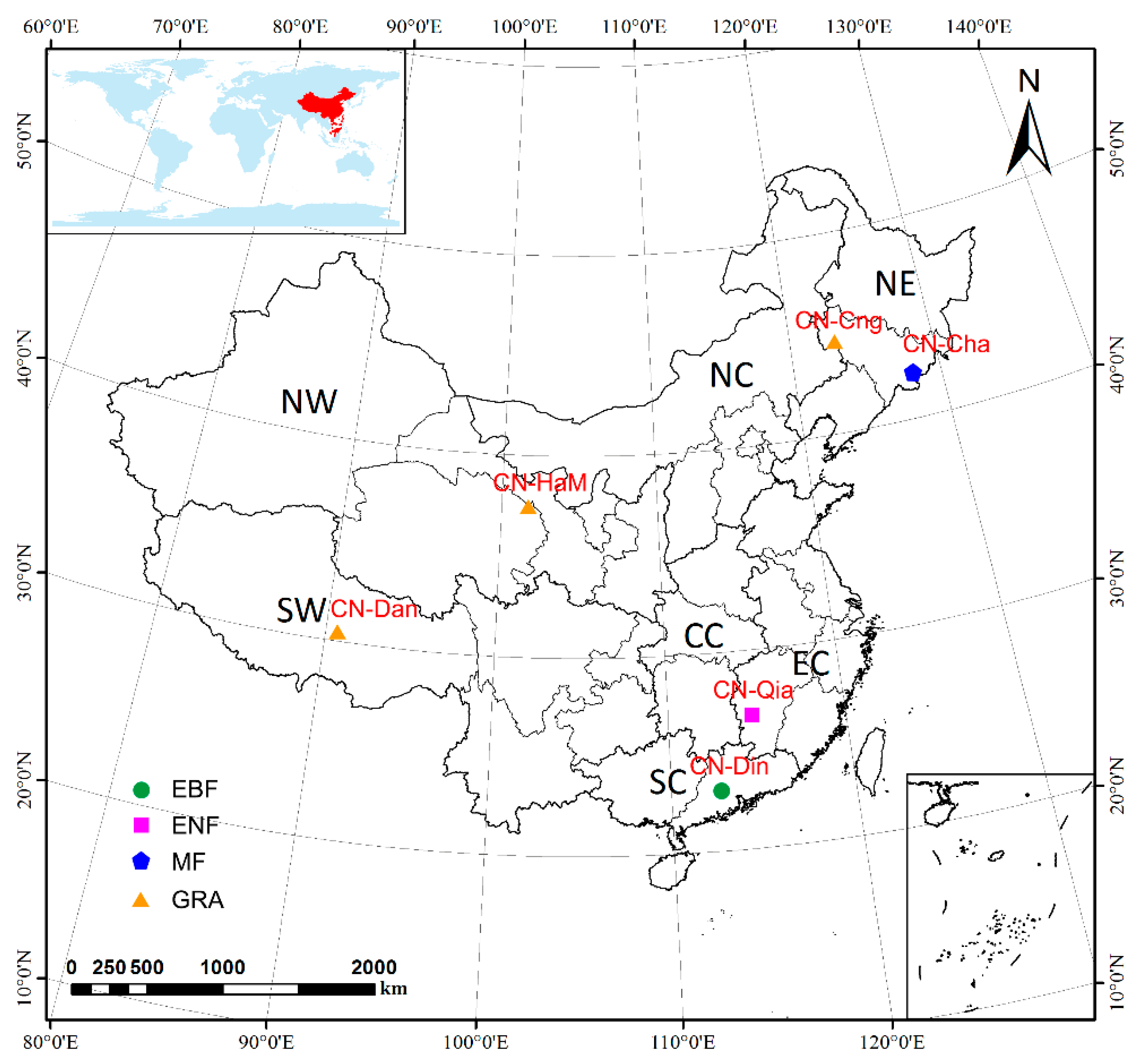
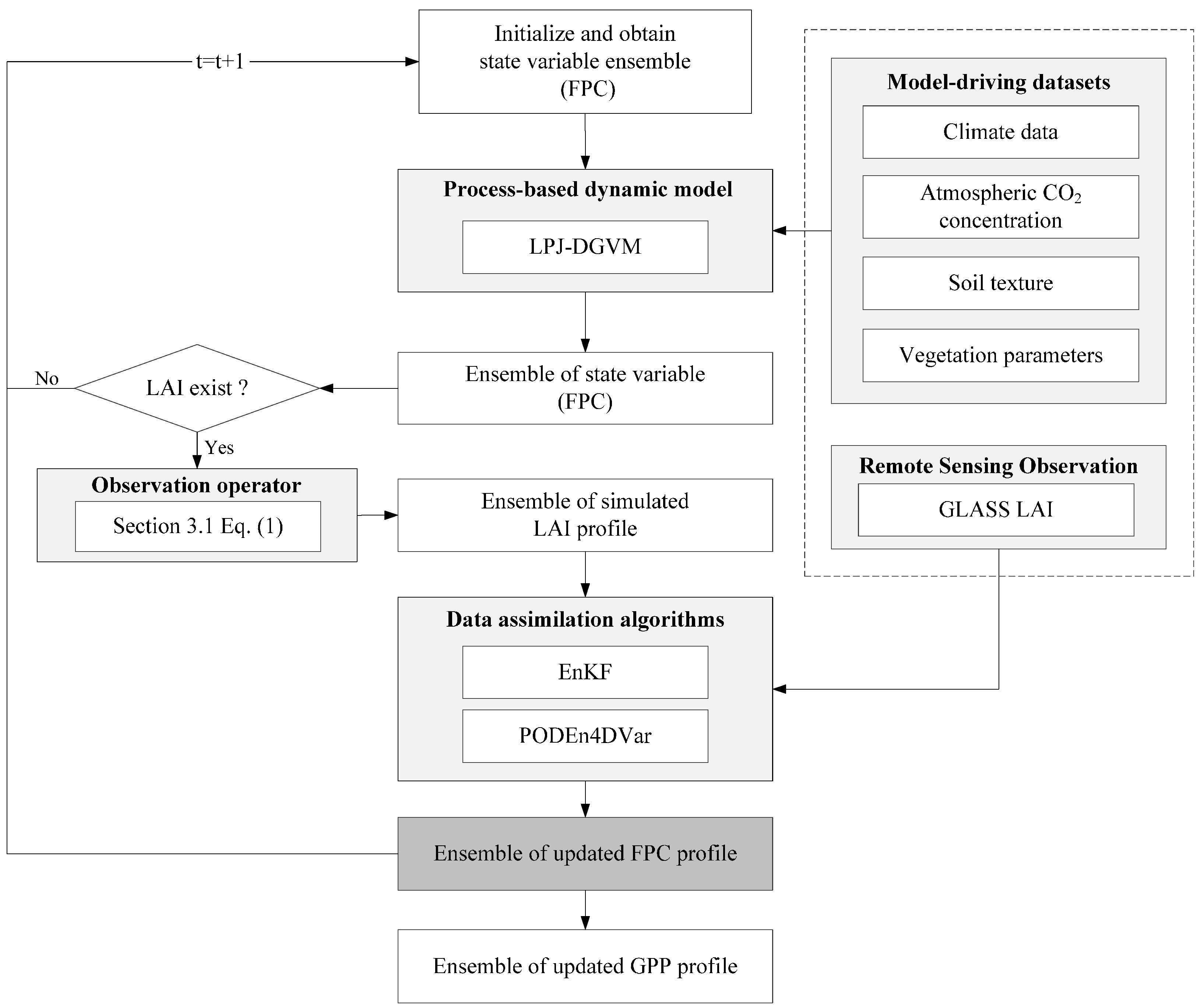
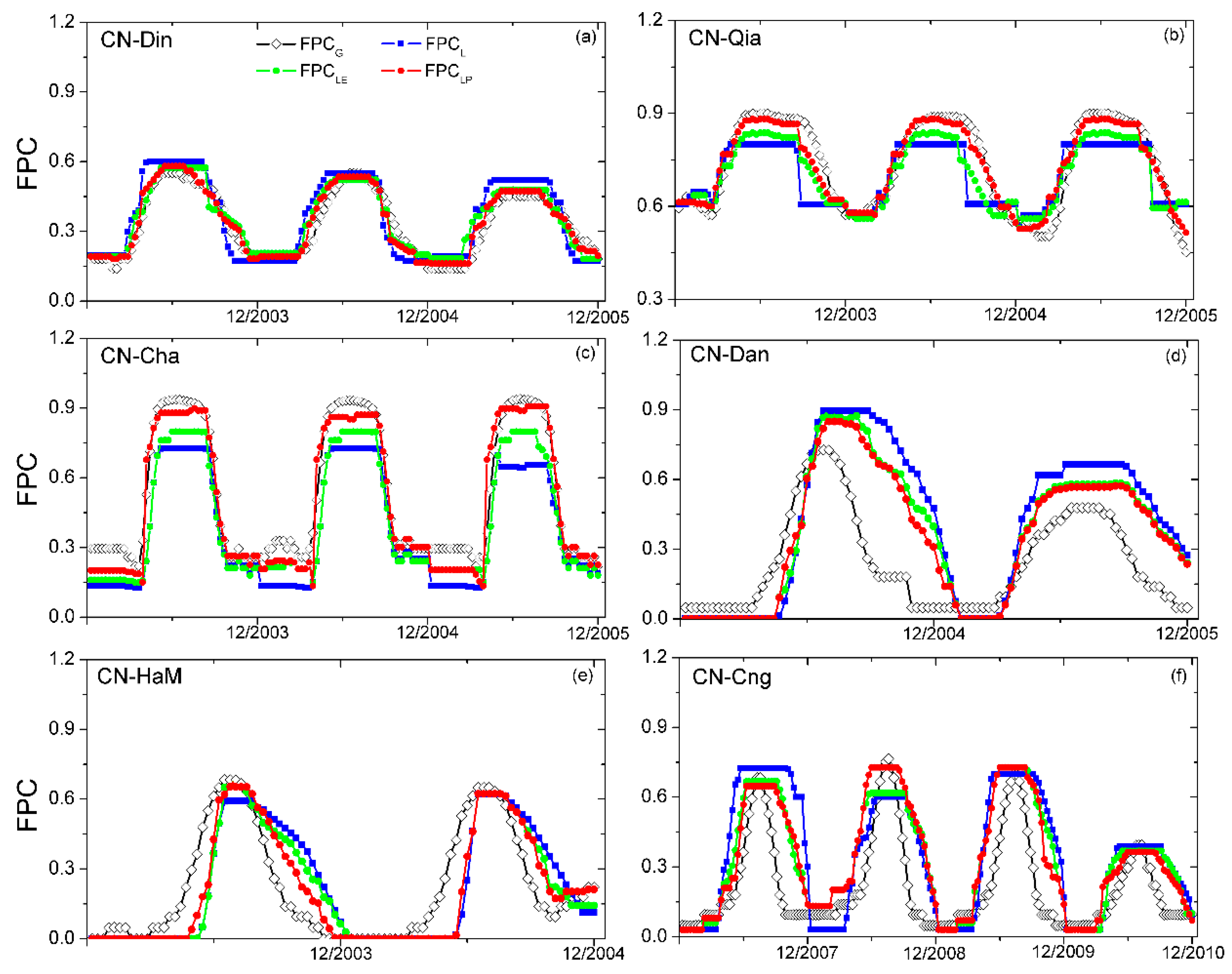

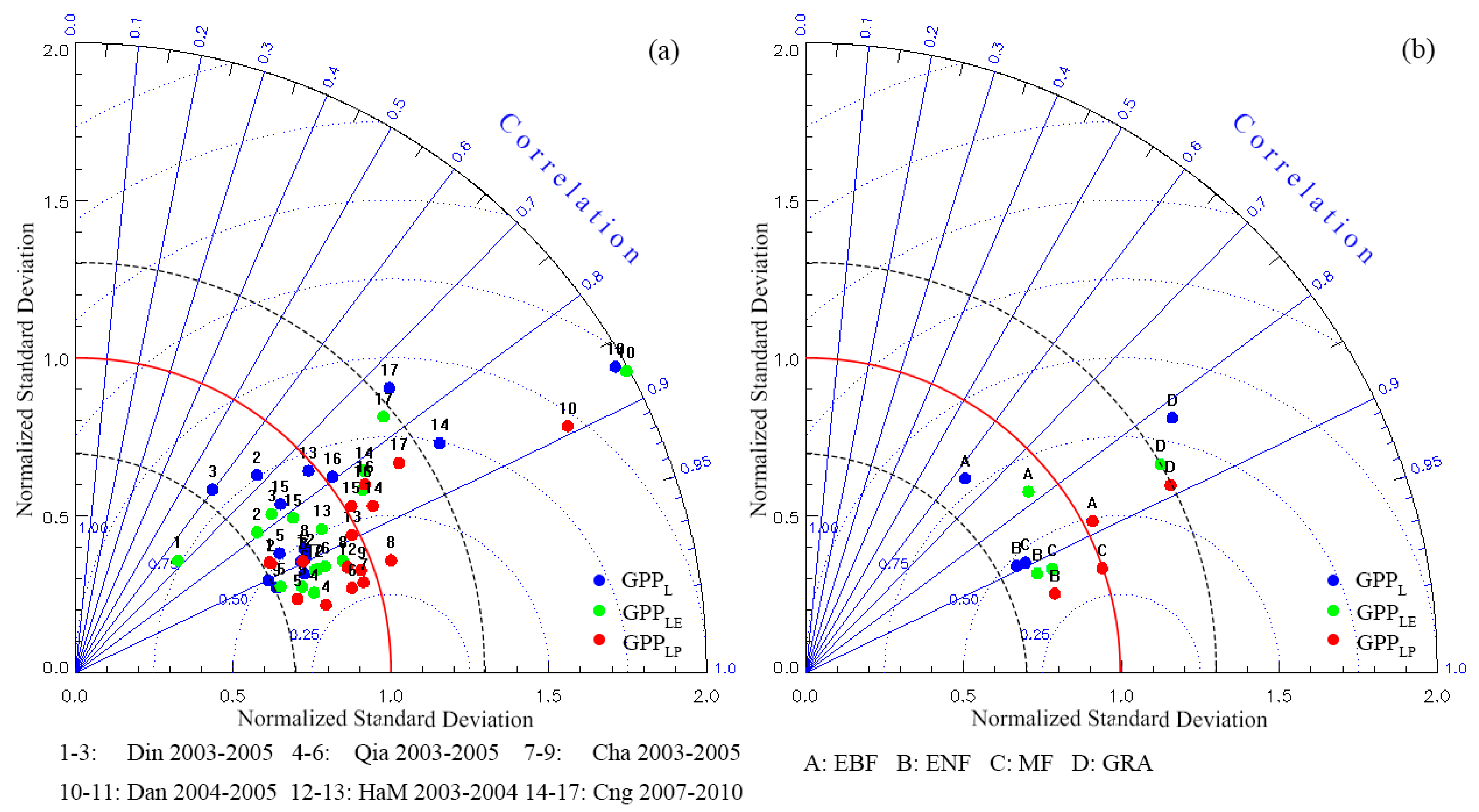

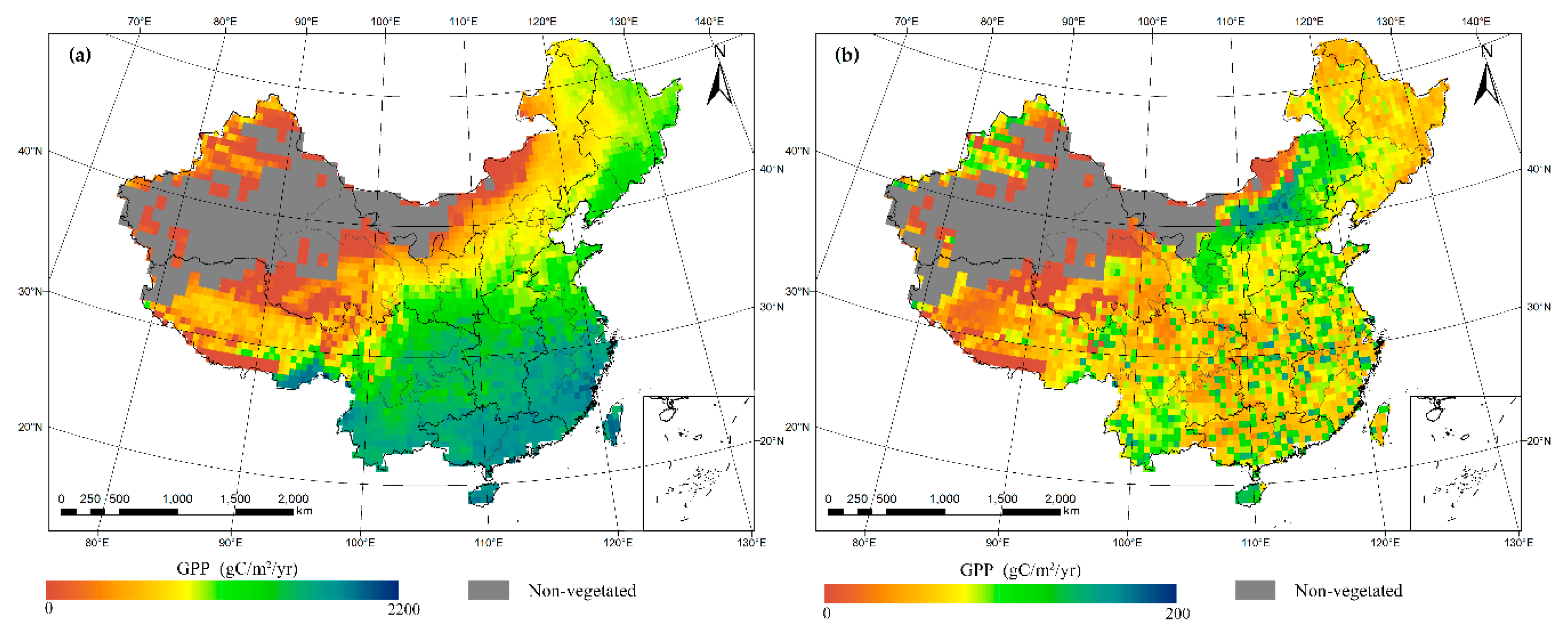
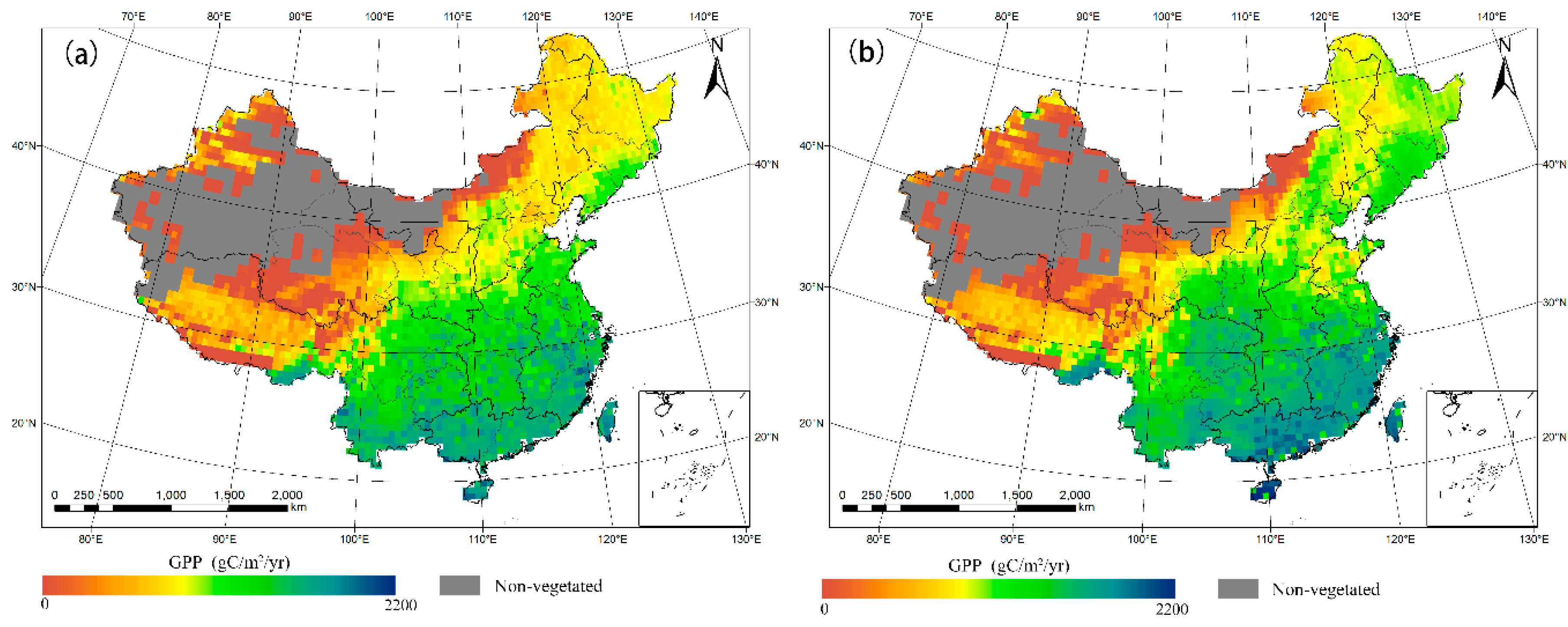
| No. | Site Code | Site Name | Latitude (°N) | Longitude (°E) | IGBP a | Years Used | Reference |
|---|---|---|---|---|---|---|---|
| 1 | CN-Din | Dinghushan | 23.1733 | 112.5361 | EBF | 2003–2005 | Zhou et al. (2011) [32] |
| 2 | CN-Qia | Qianyanzhou | 26.7414 | 115.0581 | ENF | 2003–2005 | Huang et al. (2013) [33] |
| 3 | CN-Cha | Changbaishan | 42.4025 | 128.0958 | MF | 2003–2005 | Zhang et al. (2009) [34] |
| 4 | CN-Dan | Dangxiong | 30.4978 | 91.0664 | GRA | 2004–2005 | Shi et al. (2006) [35] |
| 5 | CN-HaM | Haibei Alpine Tibet site | 37.3700 | 101.1800 | GRA | 2003–2004 | Kato et al. (2006) [36] |
| 6 | CN-Cng | Changling | 44.5934 | 123.5092 | GRA | 2007–2010 | Dong et al. (2011) [37] |
| r | RMSD (gC/m2/Month) | RMSDr (%) | ||||||||
|---|---|---|---|---|---|---|---|---|---|---|
| GPPL | GPPLE | GPPLP | GPPL | GPPLE | GPPLP | GPPL | GPPLE | GPPLP | ||
| Din | 2003 | - | 0.677 | 0.869 | 21.610 | 18.933 | 12.323 | 16.7 | 16.0 | 9.7 |
| 2004 | 0.677 | 0.791 | 0.873 | 32.740 | 26.829 | 22.303 | 26.0 | 21.3 | 17.5 | |
| 2005 | 0.600 | 0.778 | 0.898 | 31.032 | 24.056 | 17.289 | 27.5 | 21.3 | 15.1 | |
| Qia | 2003 | 0.902 | 0.948 | 0.965 | 38.613 | 31.383 | 17.763 | 31.6 | 25.2 | 12.2 |
| 2004 | 0.863 | 0.922 | 0.949 | 38.027 | 29.908 | 24.400 | 28.0 | 20.6 | 16.2 | |
| 2005 | 0.918 | 0.920 | 0.956 | 32.228 | 26.974 | 19.791 | 27.7 | 21.4 | 14.3 | |
| Cha | 2003 | 0.896 | 0.919 | 0.954 | 56.923 | 50.171 | 35.961 | 55.9 | 47.9 | 31.5 |
| 2004 | 0.879 | 0.922 | 0.942 | 58.590 | 46.209 | 43.410 | 54.3 | 39.5 | 33.7 | |
| 2005 | 0.921 | 0.935 | 0.941 | 56.983 | 47.964 | 39.624 | 67.9 | 52.7 | 35.0 | |
| Dan | 2004 | 0.870 | 0.877 | 0.894 | 40.668 | 41.343 | 32.211 | 87.4 | 87.0 | 75.3 |
| 2005 | 0.958 | 0.958 | 0.965 | 50.924 | 41.976 | 37.071 | 103.4 | 91.9 | 88.0 | |
| HaM | 2003 | 0.895 | 0.919 | 0.932 | 38.294 | 34.898 | 31.873 | 85.0 | 77.6 | 70.5 |
| 2004 | 0.756 | 0.864 | 0.895 | 57.797 | 44.210 | 38.521 | 121.5 | 95.4 | 75.0 | |
| Cng | 2007 | 0.846 | 0.819 | 0.872 | 46.552 | 36.920 | 30.618 | 69.9 | 68.2 | 57.8 |
| 2008 | 0.773 | 0.815 | 0.856 | 50.716 | 45.762 | 47.182 | 75.1 | 70.3 | 59.8 | |
| 2009 | 0.795 | 0.843 | 0.838 | 41.552 | 37.908 | 38.517 | 69.4 | 62.9 | 65.4 | |
| 2010 | 0.741 | 0.769 | 0.839 | 56.017 | 49.835 | 39.929 | 74.9 | 70.0 | 61.3 | |
| r | RMSD (gC/m2/Month) | RMSDr (%) | |||||||
|---|---|---|---|---|---|---|---|---|---|
| GPPL | GPPLE | GPPLP | GPPL | GPPLE | GPPLP | GPPL | GPPLE | GPPLP | |
| EBF | 0.635 | 0.776 | 0.884 | 28.878 | 23.501 | 17.779 | 0.235 | 0.197 | 0.145 |
| ENF | 0.892 | 0.919 | 0.953 | 36.403 | 29.478 | 20.837 | 0.292 | 0.224 | 0.144 |
| MF | 0.894 | 0.921 | 0.943 | 57.504 | 48.142 | 39.781 | 0.587 | 0.462 | 0.335 |
| GRA | 0.821 | 0.862 | 0.889 | 48.036 | 41.478 | 36.527 | 0.917 | 0.817 | 0.723 |
| Model | GPP (PgC/yr) | Period | Reference |
|---|---|---|---|
| CASA | 5.14–5.92 | 1982–2003 | Gao et al. (2008) [81] |
| GLOPEM | 5.52–6.62 | 1981–2000 | Gao et al. (2008) [81] |
| TEPC | 7.356 | 1993–1999 | Liu et al. (2001) [82] |
| RSM | 12.26 | 1990 | Chen et al. (2001) [83] |
| EC-LUE | 5.63–6.39 | 2000–2009 | Li et al. (2013) [63] |
| VPM | 4.87–5.16 | 2006–2008 | Chen et al. (2014) [84] |
| BEPS | 5.26–5.68 | 2000–2010 | Liu et al. (2013) [64] |
| LPJ-POD | 5.92–6.67 | 2003–2012 | this study |
© 2017 by the authors. Licensee MDPI, Basel, Switzerland. This article is an open access article distributed under the terms and conditions of the Creative Commons Attribution (CC BY) license ( http://creativecommons.org/licenses/by/4.0/).
Share and Cite
Ma, R.; Zhang, L.; Tian, X.; Zhang, J.; Yuan, W.; Zheng, Y.; Zhao, X.; Kato, T. Assimilation of Remotely-Sensed Leaf Area Index into a Dynamic Vegetation Model for Gross Primary Productivity Estimation. Remote Sens. 2017, 9, 188. https://doi.org/10.3390/rs9030188
Ma R, Zhang L, Tian X, Zhang J, Yuan W, Zheng Y, Zhao X, Kato T. Assimilation of Remotely-Sensed Leaf Area Index into a Dynamic Vegetation Model for Gross Primary Productivity Estimation. Remote Sensing. 2017; 9(3):188. https://doi.org/10.3390/rs9030188
Chicago/Turabian StyleMa, Rui, Li Zhang, Xiangjun Tian, Jiancai Zhang, Wenping Yuan, Yi Zheng, Xiang Zhao, and Tomomichi Kato. 2017. "Assimilation of Remotely-Sensed Leaf Area Index into a Dynamic Vegetation Model for Gross Primary Productivity Estimation" Remote Sensing 9, no. 3: 188. https://doi.org/10.3390/rs9030188
APA StyleMa, R., Zhang, L., Tian, X., Zhang, J., Yuan, W., Zheng, Y., Zhao, X., & Kato, T. (2017). Assimilation of Remotely-Sensed Leaf Area Index into a Dynamic Vegetation Model for Gross Primary Productivity Estimation. Remote Sensing, 9(3), 188. https://doi.org/10.3390/rs9030188





